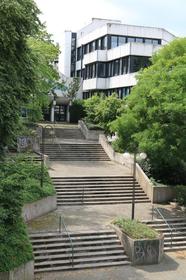School Highlights
EDP University of Puerto Rico Inc-San Sebastian serves 1,523 students (37% of students are full-time).
The college's student-teacher ratio of 14:1 is lower than the state community college average of 16:1.
Minority enrollment is 100% of the student body (majority Hispanic), which is less than the state average of 99%.
Quick Facts (2025-26)
- Enrollment: 1,523 students
- Private-state tuition: $6,060
- Acceptance Rate: 92%
- Student-teacher ratio: 14:1
- Minority enrollment: 100%
- Source: Integrated Postsecondary Education Data System (IPEDS)
Top Rankings
EDP University of Puerto Rico Inc-San Sebastian ranks among the top 20% of public schools in Puerto Rico for:
Category
Attribute
School Overview
The teacher population of 106 teachers has stayed relatively flat over five years.
EDP University of Puerto Rico Inc-San Sebastian
(PR) Community College Avg.
Carnegie Classification
Special Focus Four-Year: Other Health Professions Schools
Not applicable, not in Carnegie universe (not accredited or nondegree-granting)
Institution Level
Four or more years
Four or more years
Institution Control
Private not-for-profit
Private not-for-profit
Total Faculty
106 staff
70 staff
Student Body
The student population of EDP University of Puerto Rico Inc-San Sebastian has grown by 37% over five years.
The student-teacher ratio of 14:1 has increased from 9:1 over five years.
The EDP University of Puerto Rico Inc-San Sebastian diversity score of 0.11 is less than the state average of 0.18. The school's diversity has stayed relatively flat over five years.
Total Enrollment
1,523 students
588 students
Student-Teacher Ratio
14:1
16:1
# Full-Time Students
562 students
463 students
# Part-Time Students
961 students
125 students
# Enrollment Undergraduate
146 students
323 students
# Full-Time Undergraduate Students
541 students
408 students
# Full-Time Graduate Students
21 students
167 students
# Part-Time Undergraduate Students
919 students
109 students
# Part-Time Graduate Students
42 students
42 students
% Hispanic
94%
90%
% Black
6%
7%
% White
n/a
1%
% Unknown races
n/a
2%
Diversity Score
0.11
0.18
College Completion Rate (Students who graduate in less than 4 years)
n/a
50%
College Completion Rate (Students who graduate in 4 years or more than 4 years)
37%
42%
Average Graduate Earnings (10 Years)
$21,300
$20,600
Tuition and Acceptance Rate
The private state tuition of $6,060 is less than the state average of $6,590. The private state tuition has stayed relatively flat over four years.
Private State Tuition Fees
$6,060
$6,590
% Students Receiving Some Financial Aid
91%
96%
Median Debt for Graduates
$11,400
$5,064
Median Debt for Dropouts
$5,500
$3,500
Acceptance Rate
92%
77%
SAT Reading
n/a
422
SAT Math
n/a
456
Source: 2024 (or latest year available) Integrated Postsecondary Education Data System (IPEDS) , School Administrators
Frequently Asked Questions
How much does EDP University of Puerto Rico Inc-San Sebastian cost?
EDP University of Puerto Rico Inc-San Sebastian's private state tuition is approximately $6,060.
What is the acceptance rate of EDP University of Puerto Rico Inc-San Sebastian?
The acceptance rate of EDP University of Puerto Rico Inc-San Sebastian is 92%, which is higher than the state average of 77%.
What is EDP University of Puerto Rico Inc-San Sebastian's ranking?
EDP University of Puerto Rico Inc-San Sebastian ranks among the top 20% of community college in Puerto Rico for: Average community college minority breakdown.
Recent Articles

Community Colleges: A to Z – 2025 Guide
Explore the A–Z of community colleges in 2025: programs, affordability, pathways, and innovations for educators and parents.

Community College vs. Dual Enrollment 2025
Compare community college and dual enrollment in 2025. A parent’s guide to affordability, transfer credits, and student success pathways.

Will My Child’s Credits Transfer? Parent’s 2025 Guide
Learn how to ensure your child’s credits transfer in 2025. A parent’s guide to transfer policies, pitfalls, and planning for success.





